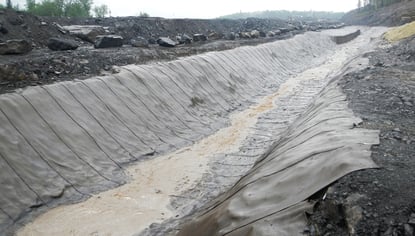.png?width=400&height=75&name=TITAN%20CASE%20STUDY%20(1).png)
Mine Channel Aged

Industry
Civil Infrastructure
Challenge:
In February 2012, Willow Creek mine faced the challenge of lining a 650-meter-long, up to 12-meter-wide and 5-meter-deep industrial waste carrier drain in remote northeastern British Columbia, requiring a fast, durable, and low-maintenance solution suitable for harsh mining conditions.
Achievement:
A total of 10,150m² of Concrete Canvas® was installed on schedule in under six weeks at a remote, weather-challenged site, delivering substantial cost savings and demonstrating clear advantages over traditional concreting methods in speed, ease, and efficiency.
Product Used:
Concrete Canvas®
Location: Willow Creek mine, British Columbia, Canada
Project Type: Product Supply
Product Used: Concrete Canvas® CC8™ CC13™ Bulk Rolls
Project Context
In February 2012, Concrete Canvas® GCCM* (CC) was used to line a carrier drain channel on the Willow Creek mine site in British Columbia, Canada.
Willow Creek is a large open pit mine located 45 kilometres west of the town of Chetwynd, in northeast British Columbia. The mine is a truck and shovel operation and is capable of producing both hard coking coal and low-volatile PCI coal for steelmaking.
The carrier drain channel was 10.5–12m wide, between 3–5m deep and approximately 650m long. The purpose of the carrier channel was to direct mining industrial waste from Willow Creek mine to a nearby settling pond.
The overall size, performance requirements of this particular application, as well as the cost potential meant that Ledcor were reluctant to use Shotcrete.
The client also specified that the lined channel had to be as water tight as possible, could handle freeze/thaw conditions, due to the cold winter temperatures in the area, and should be easy to repair. Following the recent success of a 52,000m² CC installation in the Alta Montaña III region of Chile, contractors Ledcor Group specified CC as a protective liner for the channel.
CC8™ and CC13™ were specified for the project and dispensed in bulk rolls from a spreader beam and plant equipment. The material was unrolled and cut to length on site, minimising waste as lengths were cut to match each section of the channel’s profile. No perishable formwork or additional reinforcement was required.
CC layers were laid transversely across the width of the channel, with subsequent layers overlapping by 100mm and beaded with Sikaflex 1A adhesive sealant to create water tight joints. Overlaps were jointed using 25mm screws to ensure intimate contact with the substrate. Where possible, end edges were buried with loose shale and aggregate to
prevent water ingress under the CC and provide a neat termination.
The channel was excavated from a blasted rock substrate, with some sections reinforced with concrete block work. CC layers were pinned into position at the top of the profile using 10” Ardox galvanised spikes. When fixing CC to the concrete block work, Hilti rock anchors were used.
The channel terminated in a 4m diameter corrugated steel and concrete block work culvert and sump which was also lined with CC to ensure minimum water loss. This was imperative as the water was contaminated from tailings and could not come into contact with any other water sources.
Grout was chosen in areas that may be prone to heavier flows and related scouring, and used to seal edges of the material to ensure ingress would be avoided. In an effort to minimise the possibility of potential debris dams, grouting also eliminated the lip that caused from the overlaps of CC layers.
The fibre reinforcement inherent in CC gives a durability and design life well above competitor geomembrane products, whilst the integral PVC backing ensures minimal water loss in the carrier channel. The CC will moss over in time, blending in with the surrounding environment but will prevent root growing vegetation, reducing the need for maintenance of the channel.
A swale was formed on the north ridge of the ditch at a nearby tree line to collect surface rainfall from an adjacent hillside, using the ability of CC to closely follow the profile of existing slopes and negotiate tight bends and curvatures.
CC has a working time of approximately two hours from hydration, meaning that work can continue in very wet conditions. This can reduce programme disruption typically caused by bad weather when using traditional concrete solutions.
Plastic sheeting was used to protect the CC during setting when temperatures dropped to below -5ºC.
Concrete Canvas® (CC) is a Geosynthetic Cementitious Composite Mat (GCCM), a factory-produced material combining cement within geosynthetic layers that hardens when hydrated for erosion control and weed suppression.
Summary
A total of 10,150m² of CC material was installed by Ledcor Group on scheldule in under six weeks, on a remote site and in difficult weather conditions. Ledcor were impressed with their first experience of installing CC, noting several advantages of using CC compared to traditional concreting methods: speed and ease of installation, minimal amount of training or specialist equipment required, ability to install CC in all weather conditions, minimal waste material compared to shotcreting. CC also provided substantial cost savings for the project.
Testimonials
“The end result is that there would have been an extra zero on the end of the price quote, if we had elected to use Shotcrete.”
Bud Fassnacht
Ledcor Group,
Superintendent
“As an engineer, I liked the fact that CC was adaptable to changes in channel shape as we had segments of trapezoidal shape that had to transition to a rectangular shape. The drape characteristic allowed the CC to be placed on a pretty rough surface. Finally it seems that any future damages to the CC will be easily fixed by patching.
This should result in very low maintenance costs.”
Michael Graham
Senior Geotechnical Engineer,
Norwest Corporation



-1.jpg?width=5972&height=5972&name=StormSmart%20Tank_Brantford_ON_July2025%20(1)-1.jpg)
